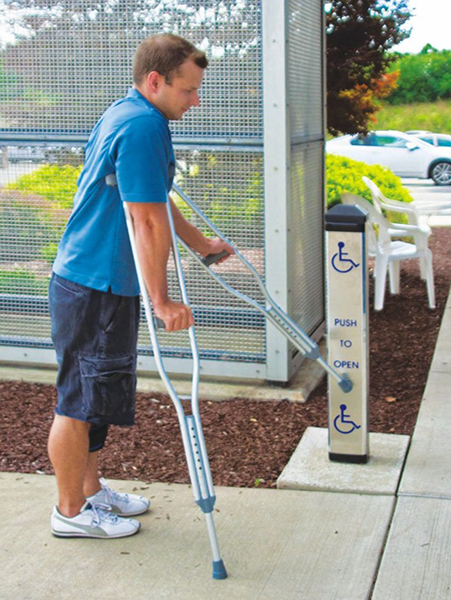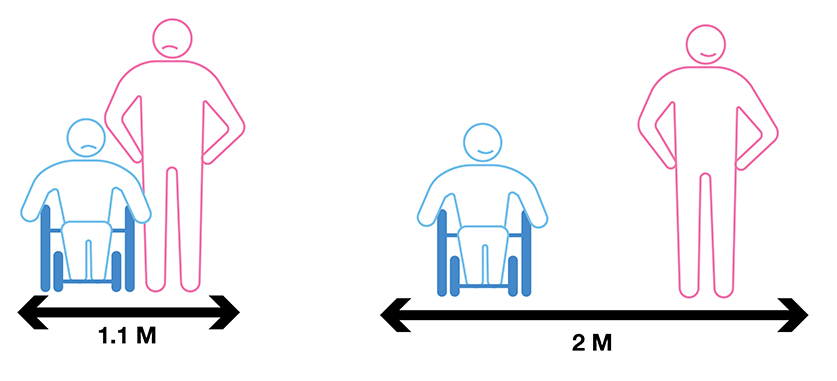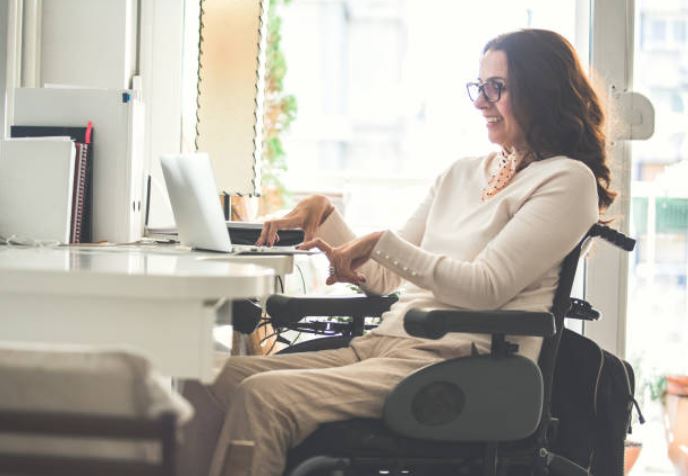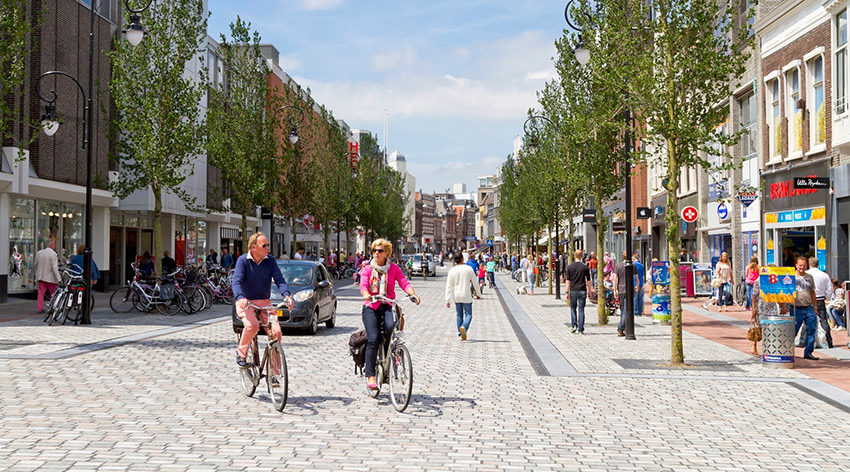
By Laurène Bachand, Architect
Universal design is simple and inclusive. It is to ensure an environment can be accessed, understood, and used to the greatest extent possible by all people regardless of their age, size, or ability. It is not ‘just’ for wheelchairs. It is for all of us, at different stages of our lives.
As designers, we need to question how this pandemic can have a positive input on our built environment. I was wondering: could the pandemic be an opportunity to rethink the universal accessibility of our public spaces?
 The National Building Code Section 3.8 Barrier-Free Design reinforces universal accessible design in Canada. In Manitoba, amendments were made to build on some of the already listed requirements. For example, every exterior door accessible to the public is to be equipped with an automatic door actuator (a little push button). Currently, there are no requirements for that button to be activated by feet, instead of by hands. For some, pushing a button with their hands is a difficult or impossible task. Due to the new hygienic measures, could we see this requirement changing? Full length actuators could be used to limit human contact and ease access to buildings for many, including those with immunity concerns. These actuators are already available on the market and have been mandatory on all city of Winnipeg owned projects since 2015.
The National Building Code Section 3.8 Barrier-Free Design reinforces universal accessible design in Canada. In Manitoba, amendments were made to build on some of the already listed requirements. For example, every exterior door accessible to the public is to be equipped with an automatic door actuator (a little push button). Currently, there are no requirements for that button to be activated by feet, instead of by hands. For some, pushing a button with their hands is a difficult or impossible task. Due to the new hygienic measures, could we see this requirement changing? Full length actuators could be used to limit human contact and ease access to buildings for many, including those with immunity concerns. These actuators are already available on the market and have been mandatory on all city of Winnipeg owned projects since 2015.
A lot of hands-free gadgets are making their way to the market to limit the spread of germs. Designers need to question if these are promoting access for all or limiting it. Can a senior with severe arthritis or a teen with a temporary fracture use it? Can a parent with a million things, let alone a small human, in their arms use it? Can a young adult with muscular dystrophy use it? Limiting transmission of germs is important, but the basic human right to universal access should remain a priority.  The minimum aisle width in any public building is 1.1 meters. This is much less than the 2 meters recommended by the health authorities, but also less than a mobility scooter needs to make a full 360-degree rotation. I had the misfortune to have to do my Christmas shopping in a wheelchair due to an injury. It was close to impossible, and incredibly infuriating. My experience was temporary, but many need to adapt to the restrictive conditions of our built environment, every day of their lives. Could this new 2-meter self-distancing requirement lead to more open space in retail and a better shopping experience for all?
The minimum aisle width in any public building is 1.1 meters. This is much less than the 2 meters recommended by the health authorities, but also less than a mobility scooter needs to make a full 360-degree rotation. I had the misfortune to have to do my Christmas shopping in a wheelchair due to an injury. It was close to impossible, and incredibly infuriating. My experience was temporary, but many need to adapt to the restrictive conditions of our built environment, every day of their lives. Could this new 2-meter self-distancing requirement lead to more open space in retail and a better shopping experience for all?  In pre-pandemic times, airports, convention centers and other large-scale public buildings had already started implementing hands-free washroom accessories, plumbing fixtures, and automatic doors with motion sensors. Could this lead to the implementation of such devices in smaller sized projects?
In pre-pandemic times, airports, convention centers and other large-scale public buildings had already started implementing hands-free washroom accessories, plumbing fixtures, and automatic doors with motion sensors. Could this lead to the implementation of such devices in smaller sized projects?
Apartment footprints have become smaller and smaller. Developer proformas need to be profitable and with employment uncertainty that some are facing, many tenants are  not ready or able, to afford an increase in rent. Although, I do not see a drastic increase in livable area happening, mostly due to prohibitive construction costs, there might be creative solutions to better incorporate the home office we had to improvise a few weeks ago. The ability to work from home, in a comfortable and well-adapted space with access to the right technologies, may open the doors of employment to people who previously could not commute to an office space, for any reason, including disability. Unfortunately, many workplaces are not yet designed for people with disabilities, limiting employment options. With working from home becoming more widely accepted, could this barrier to employment be mitigated?
not ready or able, to afford an increase in rent. Although, I do not see a drastic increase in livable area happening, mostly due to prohibitive construction costs, there might be creative solutions to better incorporate the home office we had to improvise a few weeks ago. The ability to work from home, in a comfortable and well-adapted space with access to the right technologies, may open the doors of employment to people who previously could not commute to an office space, for any reason, including disability. Unfortunately, many workplaces are not yet designed for people with disabilities, limiting employment options. With working from home becoming more widely accepted, could this barrier to employment be mitigated?
At an urban level, there is a lot of discourse in dense cities for widening the sidewalks, an act that gives the city back to its people. My daily walk has become a game of avoiding others on 1.5-meter-wide sidewalks (again, less than the 2-meter recommended). Imagine the challenge of the game in winter. Could our new situation be an incentive for cities to prioritize snow cleaning? Better yet, could this new constraint increase the number of woonerfs in the country? Woonerfs are Dutch roads in which techniques (bollards, pavement material, low curb height, low speed limit signs, etc.) are used to reduce and slower car traffic, enhancing the pedestrian activity throughout neighborhoods. Both measures would help us stay 2 meters apart, but would also allow wheelchair users, seniors with walking aids and families with strollers to walk throughout the city safely.
 Dutch Woonerf
Dutch Woonerf
So, could this pandemic become an opportunity to rethink the universal accessibility of our public spaces? I think it can, and I am hopeful our ’new normal’ will lead to better universal accessibility throughout our built environment. There is obviously a cost related to all of this, but our continued confinement from a world that cannot accommodate life during an outbreak is taking a much larger toll on our economy than these accommodations would ever cost.
Laurène is an Architect and Residential/Commerical Studio Lead at Number TEN Architectural Group

